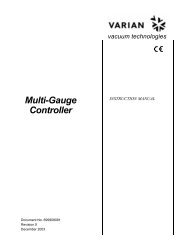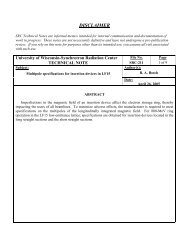SRC Users' Meeting - Synchrotron Radiation Center - University of ...
SRC Users' Meeting - Synchrotron Radiation Center - University of ...
SRC Users' Meeting - Synchrotron Radiation Center - University of ...
You also want an ePaper? Increase the reach of your titles
YUMPU automatically turns print PDFs into web optimized ePapers that Google loves.
PHOTOELECTRON SPECTROMETRY OF ATOMIC CHROMIUM IN<br />
THE REGION OF THE 3P TO 3D GIANT RESONANCE<br />
Scott B. Whitfield 1 , Brian Krosschell 1 , and Ralf Wehlitz 2<br />
1 Department <strong>of</strong> Physics and Astronomy, <strong>University</strong> <strong>of</strong> Wisconsin, Eau Claire, WI 54701<br />
2 <strong>Synchrotron</strong> <strong>Radiation</strong> <strong>Center</strong>, <strong>University</strong> <strong>of</strong> Wisconsin, Stoughton, WI 53589<br />
Atomic Cr, by virtue <strong>of</strong> its half filled 3d and 4s subshells, [Ar]3d 5 4s 1 ( 7 S 3 ), is one <strong>of</strong> the<br />
simplest open-shell atoms to have a partially filled d subshell. This makes detailed studies <strong>of</strong><br />
atomic Cr particularly attractive both theoretically and experimentally. In fact, atomic Cr has<br />
been the object <strong>of</strong> fairly extensive experimental and theoretical investigations [1]. Nevertheless,<br />
there is presently no experimental data <strong>of</strong> the angular distribution parameters, , <strong>of</strong> the Cr<br />
mainlines. Only recently has there been any theoretical calculations <strong>of</strong> [2] and this for the 3d<br />
photoelectron only. This lack <strong>of</strong> experimental data for prompted us to investigate its photon<br />
energy dependence for both the 3d and 4s mainlines and the strongest photoelectron satellite line<br />
in the region <strong>of</strong> the 3p 3d giant resonance. A comparison between our measured values as a<br />
function <strong>of</strong> photon energy for the 3d mainline and theory is shown in the figure below. There is<br />
generally good accord between experiment and theory with the exception <strong>of</strong> certain resonance<br />
transitions which were not accounted for by theory.<br />
We have also found strong<br />
deviations from = 2.0 for the 4s<br />
mainline on most <strong>of</strong> the 3p 3d<br />
resonances, while <strong>of</strong>f resonance they have<br />
values <strong>of</strong> 2.0 as generally expected. For<br />
half-open shubshell atoms one generally<br />
expects s-subshell photoelectrons to have<br />
= 2.0 independent <strong>of</strong> the incident<br />
photon energy. Deviations from this<br />
behavior are an indication <strong>of</strong> relativistic<br />
effects. We will present a simple<br />
qualitative argument for why we observe<br />
deviations <strong>of</strong> = 2.0 for the 4s mainline<br />
on resonance.<br />
This work was supported by a Research Corporation College Cottrell Grant No. CC5243.<br />
The <strong>SRC</strong> is operated under Grant No. DMR-0084402.<br />
References:<br />
[1] Th. Dohrmann, A. von dem Borne, A. Verweyen, B. Sonntag, M. Wedowski, K. Godehusen,<br />
P. Zimmermann and V. Dolmatov. J. Phys. B, 29, 4641 (1996) and references therein.<br />
[2] V. K. Dolmatov, A. S. Baltenkov, and S. T. Manson, Phys. Rev. A, 67, 062714 (2003).
















